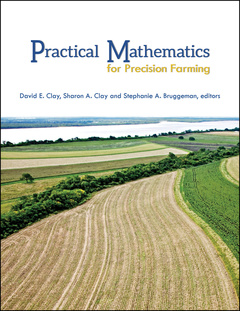Practical Mathematics for Precision Farming ASA, CSSA, and SSSA Books Series
Auteurs : Clay David E., Clay Sharon A., Bruggeman Stephanie A.

Chapter 1. A Guide to Making Mathematics Practical 7
Jo Clay
Chapter 2. Simple Programming for Automating Precision Farming Calculations 39
Aaron J. Franzen, C. Gregg Carlson, Cheryl L. Reese, and David E. Clay
Chapter 3. An Introduction to Experimental Design and Models 53
David E. Clay, Gary Hatfield, and Sharon A. Clay
Chapter 4. Mathematics of Longitude and Latitude 65
David E. Clay, Terry A. Brase, and Graig Reicks
Chapter 5. Spatial Statistics 75
Gary Hatfield
Chapter 6. Soil Sampling and Understanding Soil Testing Results for Precision Farming 105
David E. Clay, Clay Robinson, and Thomas M. DeSutter
Chapter 7. Calculations Supporting Management Zones 123
David E. Clay, Newell R. Kitchen, Emmanuel Byamukama, and Stephanie A. Bruggeman
Chapter 8. Understanding Soil Water and Yield Variability in Precision Farming 137
David E. Clay and T.P. Trooien
Chapter 9. Developing Prescriptive Soil Nutrient Maps 149
Richard B. Ferguson, Joe D. Luck, and Rachel Stevens
Chapter 10. Essential Plant Nutrients, Fertilizer Sources, and Application Rates Calculations 167
Jiyul Chang, David E. Clay, Brian Arnall, and Graig Reicks
Chapter 11. Deriving and Using an Equation to Calculate Economic Optimum Fertilizer and Seeding Rates 181
Scott Fausti, Bruce J. Erickson, David E. Clay, and C. Gregg Carlson
Chapter 12. Cost of Crop Production 191
Scott Fausti and Tong Wang
Chapter 13. Mathematics Associated with Seed Emergence, Plant Population, Stand Uniformity, and Harvest Losses 201
Stephanie A. Bruggeman, Sharon A. Clay, Cheryl L. Reese, and C. Gregg Carlson
Chapter 14. Estimating Weed and Insect Development, In-Season Yield Losses, and Economic Thresholds 209
Sharon A. Clay and Adam Varenhorst
Chapter 15. Determining the Economic Optimum Rate for Second Polynomial Plateau Models 225
Christopher J. Graham, David E. Clay, and Stephanie A. Bruggeman
Chapter 16. A Site-Specific Fertilizer Program Assessment Using Soil and Nutrient Removal Benchmarks 231
David E. Clay
Chapter 17. Understanding Grain Moisture Percentage and Nutrient Contents for Precision Grain Moisture 241
Cheryl L. Reese and C. Gregg Carlson
Chapter 18. Calculating the Impacts of Agriculture on the Environment and How Precision Farming Can Reduce These Consequences 247
Clay Robinson
Index 263
Dr. David E. Clay received a B.S degree from the University of Wisconsin (Madison), M.S. Degree from the University of Idaho, and Ph.D. from the University of Minnesota. Currently, he is Professor of Soil Science at South Dakota State University. He has served on the Editorial Board for the Agronomy Journal in a number of roles including Associate Editor, Technical Editor, and Editor (starting 2018). In addition, he is an Editor or author for 13 books and has published over 250 papers. Dr. Clay's research goal is to develop and test sustainable precision agricultural management systems that enhance environmental quality, maintain rural economies, and improve energy and economic self-suffi ciency. He has received a number of awards including two papers that awarded paper of the year, being twice selected for the ASA precision Systems Impact award, being selected twice for the SDSU College of Agriculture and Biological Sciences Outstanding Researcher, editor on three books that were awarded excellence in extension materials greater than 15 papers, selected as a Fellow of the American Society of Agronomy in 2007, being awarded the 2009 PrecisionAG Award of Excellence in Education and research, and being awarded the SDSU F.O. Butler Award for Excellence in Research.
Dr. Sharon A. Clay is a distinguished professor of weed science at South Dakota State University, Brookings, SD. She received a BS in horticulture from the University of Wisconsin-Madison, an MS in plant science from the University of Idaho, Moscow, and a PhD in agronomy from the University of Minnesota, St. Paul. She has conducted weed management studies in cropping systems including soybean, corn, wheat, barley, fl ax, sunfl ower and safflower and rangeland. Studies have included weed physiology, the infl uence of weeds on crop growth and genomic responses, and site-specific weed management strategies. Dr. Clay has published over 150 scientifi c articles and has served as ed
Date de parution : 01-2020
Ouvrage de 272 p.
1x1 cm



